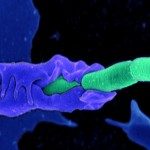Link to Pubmed [PMID] – 23453456
Prev. Vet. Med. 2013 May;110(1):12-27
Salmonella are the most common bacterial cause of foodborne infections in France and ubiquitous pathogens present in many animal productions. Assessing the relative contribution of the different food-animal sources to the burden of human cases is a key step towards the conception, prioritization and assessment of efficient control policy measures. For this purpose, we considered a Bayesian microbial subtyping attribution approach based on a previous published model (Hald et al., 2004). It requires quality integrated data on human cases and on the contamination of their food sources, per serotype and microbial subtype, which were retrieved from the French integrated surveillance system for Salmonella. The quality of the data available for such an approach is an issue for many countries in which the surveillance system has not been designed for this purpose. In France, the sources are monitored simultaneously by an active, regulation-based surveillance system that produces representative prevalence data (as ideally required for the approach) and a passive system relying on voluntary laboratories that produces data not meeting the standards set by Hald et al. (2004) but covering a broader range of sources. These data allowed us to study the impact of data quality on the attribution results, globally and focusing on specific features of the data (number of sources and contamination indicator). The microbial subtyping attribution model was run using an adapted parameterization previously proposed (David et al., 2012). A total of 9076 domestic sporadic cases were included in the analyses as well as 9 sources among which 5 were common to the active and the passive datasets. The greatest impact on the attribution results was observed for the number of sources. Thus, especially in the absence of data on imported products, the attribution estimates presented here should be considered with caution. The results were comparable for both types of surveillance, leading to the conclusion that passive data constitute a potential cost-effective complement to active data collection, especially interesting because the former encompass a greater number of sources. The model appeared robust to the type of surveillance, and provided that some methodological aspects of the model can be enhanced, it could also serve as a risk-based guidance tool for active surveillance systems.

